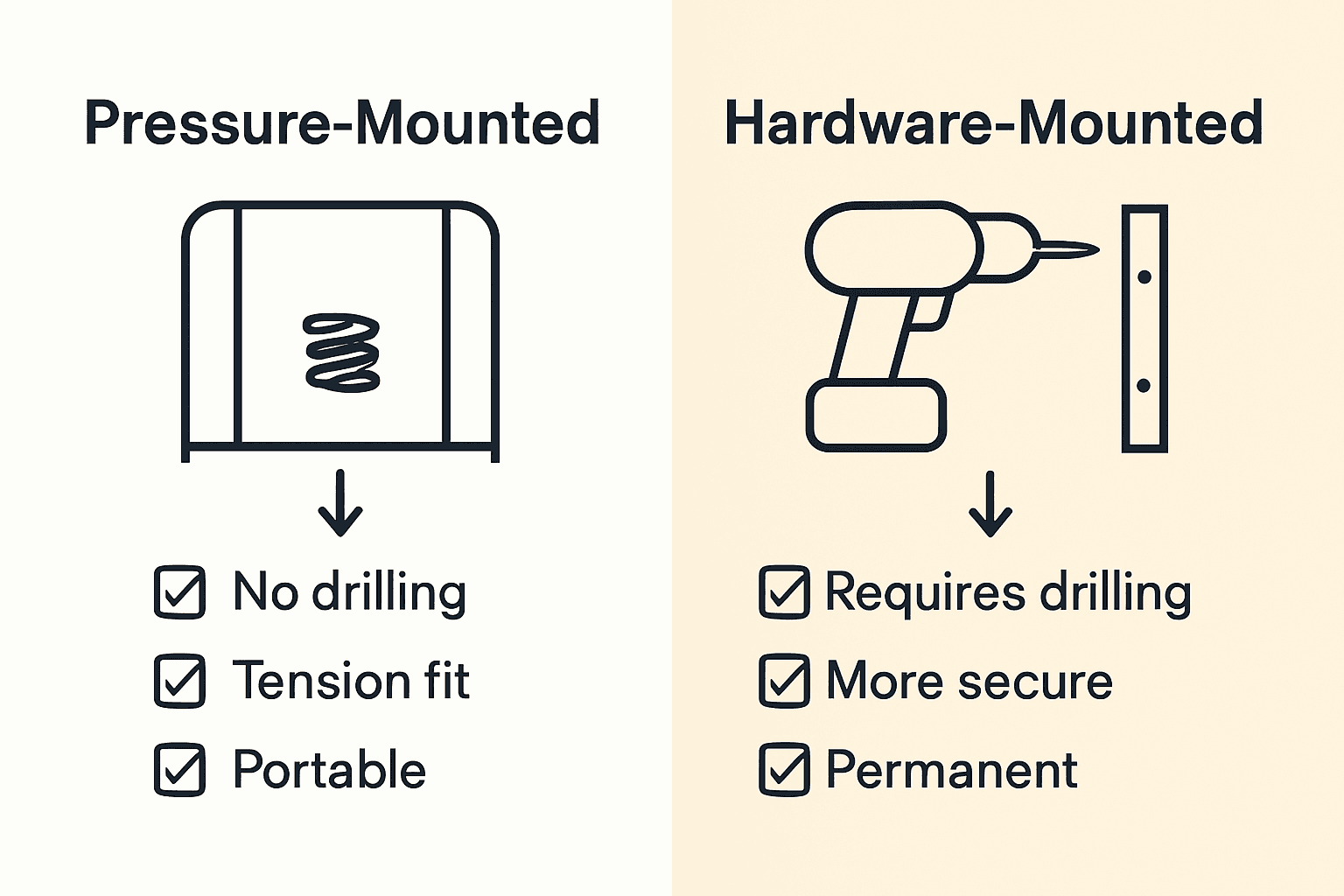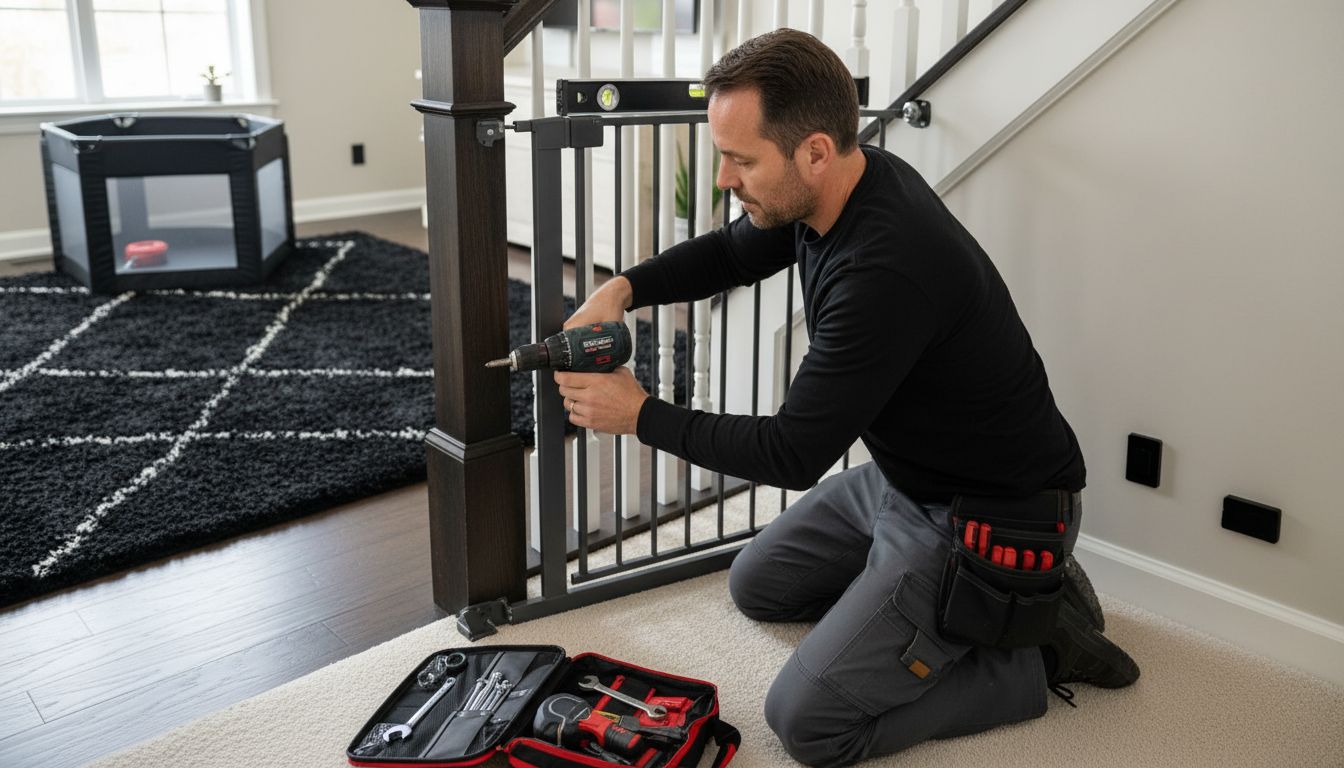
Why Use Safety Gates: Complete Guide for Families

More than 2 million children under five experience home-related injuries every year, many of which are preventable. As kids learn to crawl and walk, ordinary spaces can quickly turn hazardous without barriers in place. Safety gates serve as silent sentinels, shielding little explorers from falls, sharp objects, and off-limits rooms by creating secure play areas and peace of mind for the entire family.
Key Takeaways
| Point | Details |
|---|---|
| Safety Gates Significance | Safety gates are essential for preventing childhood accidents by creating safe zones in the home and restricting access to dangerous areas. |
| Types of Safety Gates | Pressure-mounted gates are suitable for temporary use in low-risk areas, while hardware-mounted gates provide superior security for high-risk zones like staircases. |
| Installation and Maintenance | Proper installation and regular maintenance of safety gates are critical to ensure effectiveness and safety for children. |
| Risks of Inaction | Not using safety gates significantly increases the risk of serious injuries from common household hazards, particularly in staircases and kitchens. |
Defining Safety Gates and Their Purpose
Safety gates are your home's first line of defense against childhood accidents. These protective barriers are specifically designed to block access to potentially dangerous areas, creating safe zones for your most vulnerable family members. Safety gates serve a critical purpose - preventing children from wandering into spaces that could lead to serious injuries.
Typically recommended for children between 6 and 24 months old, these ingenious devices create physical boundaries that stop curious little explorers from accessing hazardous locations. Imagine a kitchen with sharp utensils, a staircase with steep steps, or a home office with electrical equipment - safety gates transform these potential danger zones into restricted areas, giving parents peace of mind.
- Prevents falls on stairs
- Blocks access to dangerous rooms
- Creates designated safe play areas
- Restricts movement near potential hazards
Unlike temporary solutions like constant supervision, safety gates provide a consistent, reliable barrier. They are engineered with precise mechanisms to withstand a child's persistent pushing and pulling, ensuring structural integrity even under repeated stress. Whether you live in a multi-level home or have specific rooms requiring protection, these gates offer a versatile solution to childhood safety challenges.
Types of Safety Gates and Key Differences
When it comes to protecting your little ones, not all safety gates are created equal. The world of child safety barriers is diverse, offering different designs tailored to specific home environments and potential hazard zones. Understanding these variations can mean the difference between adequate protection and potential risk.
Pressure-Mounted Safety Gates
Pressure-mounted gates are the go-to solution for low-risk areas like doorways and hallways. These clever devices use adjustable tension springs to hold themselves in place between walls or door frames without requiring permanent installation. Key characteristics include:
- Quick and easy installation
- No drilling or wall damage
- Lightweight and portable
- Best for flat, even surfaces
- Ideal for temporary barriers
Hardware-Mounted Safety Gates
For high-risk areas like staircases, hardware-mounted gates reign supreme. These gates are securely anchored directly into wall studs or door frames, providing maximum stability and preventing accidental dislodging. Their robust design makes them the gold standard for preventing serious falls.
Beyond mounting styles, safety gates also differ in material composition. Families can choose from:
- Wood gates: Classic aesthetic, blend with home decor
- Metal gates: Extremely durable, modern look
- Plastic gates: Lightweight, often more affordable
Each material offers unique advantages, allowing parents to select a gate that matches both safety requirements and interior design preferences.
Here's a comparison of the main types of safety gates and their features:

| Feature | Pressure-Mounted Gates | Hardware-Mounted Gates |
|---|---|---|
| Best Use Areas | Doorways<br>Hallways | Top/Bottom of Stairs<br>High-risk zones |
| Installation | No drilling<br>Quick setup | Requires drilling<br>Permanent anchors |
| Wall Damage | None | Possible<br>Holes in wall |
| Portability | Lightweight<br>Easy to move | Fixed in place |
| Stability | Good for gentle pressure | Maximum<br>Withstands heavy force |
| Recommended For | Temporary barriers | Critical safety barriers |
Benefits of Safety Gates in the Household
Safety gates are more than just simple barriers - they're peace of mind packaged in a practical solution. These protective devices transform your home into a secure environment, offering parents and caregivers a critical tool in preventing childhood accidents. By creating strategic boundaries, safety gates allow children to explore while keeping them away from potential dangers.
Physical Protection and Injury Prevention
The primary benefit of safety gates is their ability to dramatically reduce the risk of childhood injuries. Falls remain one of the leading causes of emergency room visits for young children, and safety gates serve as a critical intervention. Whether blocking access to steep staircases, preventing tumbles from elevated surfaces, or keeping curious toddlers away from hazardous rooms, these gates act as a silent guardian.
- Prevents falls down stairs
- Blocks access to dangerous areas
- Reduces potential emergency room visits
- Creates controlled exploration zones
Psychological Benefits for Caregivers
Beyond physical protection, safety gates provide significant psychological reassurance. Caregivers can momentarily shift focus knowing their child is confined to a safe space. This reduction in constant supervision stress allows parents to multitask more efficiently, complete household chores, or simply take a brief moment of respite.
Moreover, safety gates help establish early boundaries for children. By consistently creating safe spaces, they teach young ones about spatial limitations and responsible exploration. The gates become educational tools, helping children understand safe movement and developing their spatial awareness while protecting them from potential harm.
How to Properly Install and Maintain Gates
Safety gate installation is a critical process that requires precision and careful attention to detail. While these protective barriers might look straightforward, improper installation can compromise their effectiveness and potentially put your child at risk. Understanding the nuanced steps of installation and ongoing maintenance is essential for creating a truly safe environment.
Installation Steps
Before mounting your safety gate, gather all necessary tools and carefully review the manufacturer's instructions. The installation process varies depending on whether you're using a pressure-mounted or hardware-mounted gate:
- Measure the opening width precisely
- Check wall/frame surface for compatibility
- Clean and prepare mounting surfaces
- Follow manufacturer's specific mounting instructions
- Test gate stability before allowing child access

Pressure-Mounted Gate Installation
- Adjust tension springs evenly on both sides
- Ensure gate fits snugly without gaps
- Check that mounting pads make full contact with walls
- Verify gate cannot be easily pushed or shifted
Hardware-Mounted Gate Installation
Hardware-mounted gates require more permanent commitment but offer superior security:
- Locate wall studs using a stud finder
- Mark precise drilling points
- Use appropriate screws and anchors
- Drill carefully to avoid electrical wiring
- Attach mounting brackets securely
Ongoing Maintenance and Safety Checks
Regular maintenance is crucial for keeping your safety gate functional. Perform monthly inspections to check for:
- Loose screws or mounting hardware
- Signs of wear or material fatigue
- Smooth operation of locking mechanisms
- Potential rust or structural damage
Remember, a safety gate is only as good as its installation and maintenance. Take time to understand your specific model's requirements and perform regular checks to ensure continuous protection for your little ones.
Risks of Not Using Safety Gates at Home
Children are naturally curious explorers with zero understanding of danger. Home hazards become exponentially more dangerous when left unprotected, transforming seemingly innocent spaces into potential injury zones. Without strategic barriers like safety gates, your home can quickly become a minefield of potential accidents waiting to happen.
Staircase and Vertical Risks
Staircases represent one of the most significant injury risks for young children. Without proper protection, toddlers can easily lose balance, tumble down multiple steps, and suffer serious consequences. Statistics reveal that falls are among the leading causes of emergency room visits for children under five years old. A single unprotected staircase can result in:
- Traumatic head injuries
- Broken bones
- Potential long-term developmental complications
- Permanent disability
Kitchen and Appliance Dangers
Kitchens are another critical zone where safety gates become non-negotiable. Curious children can quickly access dangerous elements like:
- Hot stovetops
- Sharp knife blocks
- Toxic cleaning supplies
- Electrical outlets
- Heavy appliances that could tip
Hidden Home Hazards
Beyond obvious risks, unprotected homes expose children to numerous subtle dangers. Uncontrolled exploration means potential contact with:
- Electrical cords
- Small objects causing choking hazards
- Unstable furniture
- Potentially toxic houseplants
- Open windows or balcony areas
The cost of not using safety gates extends far beyond potential medical expenses. Each unprotected moment represents a potential life-altering risk for your most vulnerable family members.
Protect What Matters Most With the Right Safety Gates
Your article highlights the real challenge families face every day: keeping curious children safe in a home full of hidden dangers. From preventing dangerous stair falls to blocking access to hazardous kitchens or unstable furniture, the right safety gate is not just a barrier but a vital peace-of-mind solution. Understanding the differences between pressure-mounted and hardware-mounted gates, along with choosing the right material, is crucial for effective protection.
Don't leave your child's safety to chance. Visit Baby Safety Gates to explore detailed reviews, comparisons, and expert installation tips that make finding the perfect gate simple and stress-free. Act now to create safe spaces quickly and confidently — because your child deserves nothing less than complete protection today. Start your journey to a safer home by checking out the full buying guide and learning how to install and maintain your safety gates properly.
Frequently Asked Questions
What are safety gates used for?
Safety gates are designed to block access to potentially dangerous areas in the home, such as staircases and kitchens, to prevent accidents and injuries for young children.
What types of safety gates are available?
There are two main types of safety gates: pressure-mounted gates, which are ideal for low-risk areas like doorways, and hardware-mounted gates, which provide maximum stability for high-risk areas like staircases.
How do I properly install a safety gate?
Proper installation varies by type. For pressure-mounted gates, adjust tension springs and ensure a snug fit. For hardware-mounted gates, locate wall studs, mark drilling points, and securely attach mounting brackets following the manufacturer's instructions.
Why is it important to use safety gates at home?
Using safety gates is crucial to protect young children from home hazards, such as falls down stairs, access to dangerous appliances, and unintended contact with toxic materials. They create secure boundaries for safe exploration within the home.





